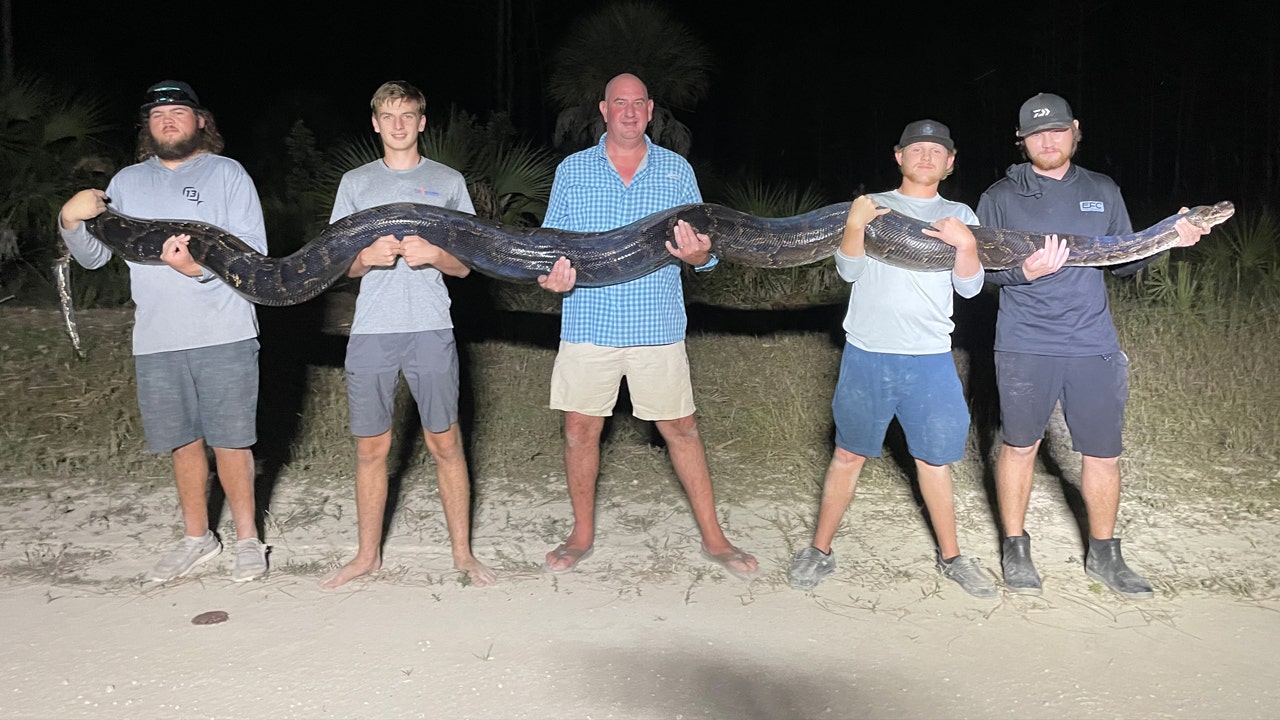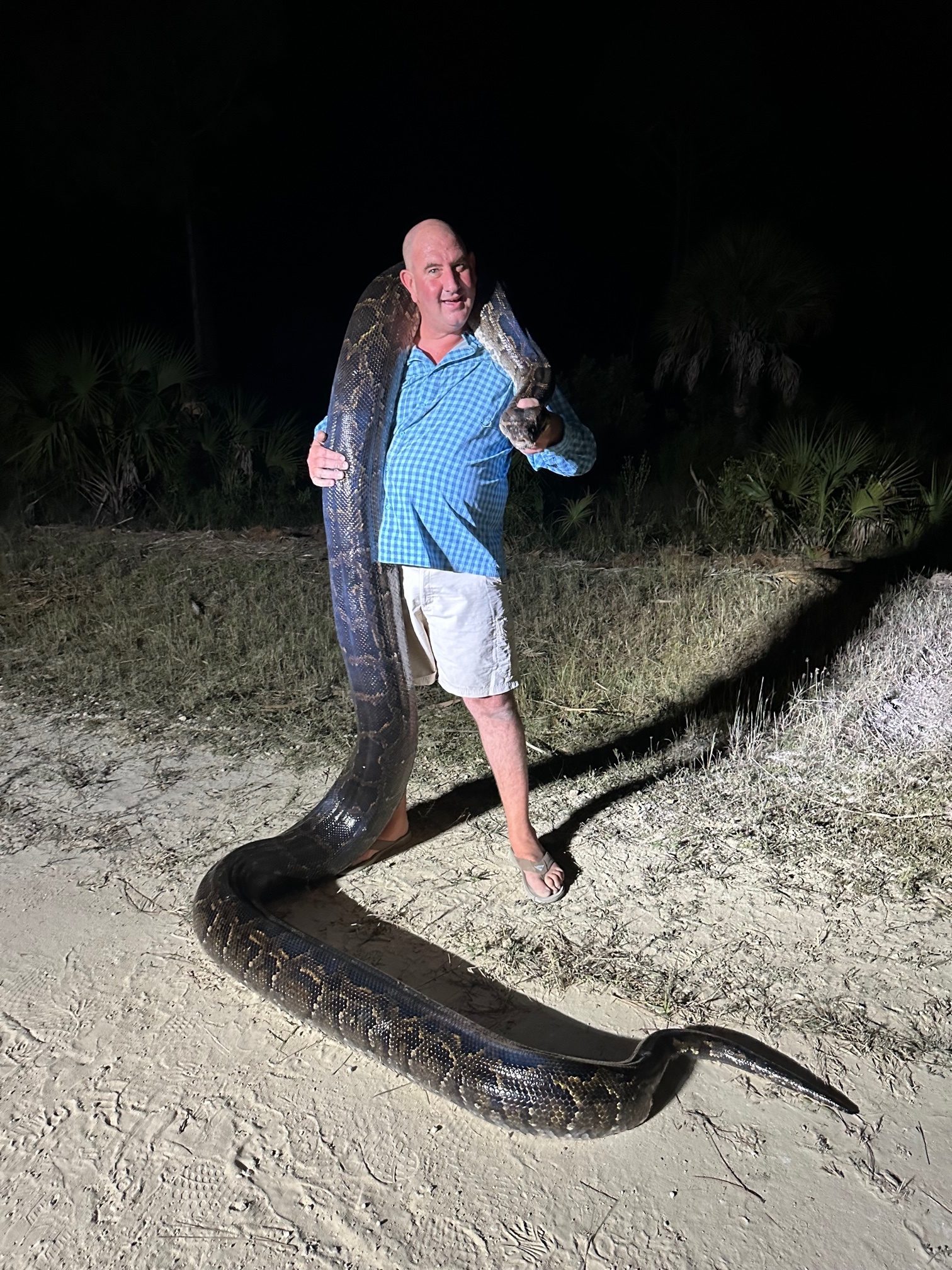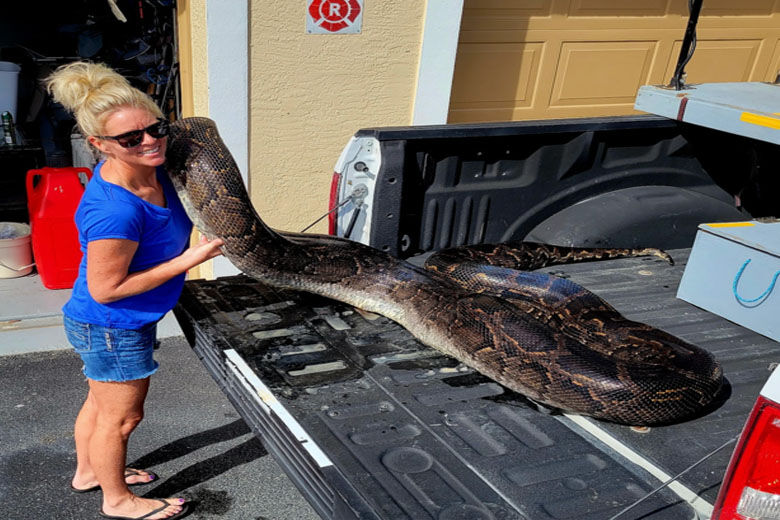Witness The Enormous 198 Lb Burmese Python, A Nature's Wonder
What is a 198 lb Burmese python? Burmese pythons are one of the largest snakes in the world, and they can grow to be over 20 feet long and weigh over 200 pounds. They are native to Southeast Asia, but they have been introduced to other parts of the world, including the United States. Burmese pythons are apex predators, and they play an important role in the ecosystem. However, they can also be a threat to humans and livestock.
In 2017, a 198 lb Burmese python was captured in the Florida Everglades. This was the largest Burmese python ever captured in the state, and it highlights the growing problem of invasive species in Florida. Burmese pythons are not native to Florida, and they have been devastating to the native wildlife. They have been known to prey on deer, alligators, and even other pythons.
The 198 lb Burmese python that was captured in 2017 was euthanized due to its size and the potential danger it posed to humans and wildlife. The Florida Fish and Wildlife Conservation Commission (FWC) is working to control the Burmese python population in Florida, but it is a difficult task. Burmese pythons are very adaptable and can survive in a variety of habitats. They also reproduce quickly, so it is difficult to keep their population under control.
- Uncover The Age Of The Enigmatic Jack Leius
- Doug Marcaidas Wife Get To Know The Woman Behind The Master Survivalist
The 198 lb Burmese python is a reminder of the growing problem of invasive species in Florida. Burmese pythons are a threat to humans, wildlife, and the environment. The FWC is working to control the Burmese python population, but it is a difficult task. Burmese pythons are very adaptable and can survive in a variety of habitats. They also reproduce quickly, so it is difficult to keep their population under control.
198 lb Burmese Python
The 198 lb Burmese python is a remarkable creature that has captured the attention of scientists, conservationists, and the general public alike. Its immense size, predatory behavior, and invasive nature raise important questions about the impact of invasive species on ecosystems and the challenges of wildlife management.
- Size: The 198 lb Burmese python is one of the largest snakes in the world, capable of reaching lengths of over 20 feet and weighing over 200 pounds.
- Apex Predator: Burmese pythons are apex predators, meaning they are at the top of their food chain and play a crucial role in regulating prey populations.
- Invasive Species: Burmese pythons are not native to Florida and have become a serious invasive species, threatening native wildlife and disrupting ecosystems.
- Conservation: The presence of the 198 lb Burmese python highlights the importance of conservation efforts to protect native species and maintain ecosystem balance.
- Habitat: Burmese pythons are highly adaptable and can survive in a variety of habitats, making their eradication difficult.
- Management: The Florida Fish and Wildlife Conservation Commission (FWC) is actively working to control the Burmese python population through various management strategies.
The 198 lb Burmese python serves as a stark reminder of the challenges and complexities of invasive species management. Its presence in Florida underscores the need for continued research, collaboration, and public awareness to address the threats posed by invasive species and protect the integrity of ecosystems.
- The Comprehensive Guide To The Snyder Cut Cast Unveiling The Heroes Villains And More
- Cardi Bs Sister Meet The Stunning Hennessy Carolina
1. Size
The immense size of the 198 lb Burmese python is a defining characteristic that significantly impacts its ecology and behavior. As one of the largest snakes in the world, its size grants it several advantages:
- Predation: The size of the Burmese python allows it to prey on a wide range of animals, including large mammals such as deer, alligators, and even other pythons. Its powerful jaws and constricting abilities enable it to subdue and consume prey much larger than itself.
- Habitat: The large size of the Burmese python also influences its habitat selection and utilization. It prefers dense vegetation and wetlands, where its size provides camouflage and protection from predators.
- Competition: The size of the Burmese python gives it a competitive edge over other predators in its ecosystem. Its sheer size and strength can intimidate or deter potential rivals, reducing competition for resources.
Understanding the size of the 198 lb Burmese python is crucial for comprehending its ecological role and the challenges it poses as an invasive species. Its immense size contributes to its predatory success, habitat preferences, and competitive abilities, making it a formidable presence in the ecosystems it inhabits.
Invasive Burmese pythons, such as the 198 lb specimen captured in Florida, have disrupted ecosystems by outcompeting native predators and preying on native wildlife. Their large size and adaptability have made them a significant conservation concern, highlighting the importance of understanding the ecological implications of invasive species and implementing effective management strategies.
2. Apex Predator
The status of the 198 lb Burmese python as an apex predator is a critical aspect of its ecological role. Apex predators are at the top of their food chain, meaning they have no natural predators and exert a significant influence on the populations of their prey species. Burmese pythons, including the 198 lb specimen, play this vital role in their native ecosystems.
As apex predators, Burmese pythons have a profound impact on the abundance and diversity of their prey. They primarily target mammals, birds, and reptiles, including large animals such as deer and alligators. By preying on these species, Burmese pythons help regulate their populations and maintain a balance in the ecosystem.
The absence of natural predators allows Burmese pythons to reach large sizes, such as the 198 lb specimen. Their size and predatory prowess give them a competitive advantage over other predators, enabling them to dominate their food chain. This, in turn, influences the behavior and distribution of prey species, shaping the overall dynamics of the ecosystem.
Understanding the role of Burmese pythons as apex predators is essential for effective wildlife management and conservation. By recognizing their importance in regulating prey populations, we can better appreciate the potential ecological consequences of their presence as an invasive species.
Invasive Burmese pythons, such as the 198 lb specimen captured in Florida, disrupt ecosystems by upsetting the natural balance between predators and prey. Their voracious appetites and lack of natural predators have led to population explosions, threatening native wildlife and altering food webs. Addressing the challenges posed by invasive Burmese pythons requires a comprehensive understanding of their ecological role as apex predators and the development of effective management strategies.
3. Invasive Species
The presence of the 198 lb Burmese python in Florida highlights the significant ecological concerns associated with invasive species. Burmese pythons are not native to Florida and have become a serious threat to the state's native wildlife and ecosystems.
- Ecological Impact: Burmese pythons, including the 198 lb specimen, have a devastating impact on native wildlife populations. They are opportunistic predators that consume a wide range of animals, including mammals, birds, and reptiles. Their voracious appetites and lack of natural predators have led to population declines among native species, disrupting ecosystem balance.
- Habitat Disruption: Burmese pythons also alter the habitats they invade. They prefer dense vegetation and wetlands, where they compete with native species for resources and modify the physical environment. Their presence can lead to changes in vegetation structure and composition, affecting the entire ecosystem.
- Competition with Native Predators: The 198 lb Burmese python and other invasive Burmese pythons pose a significant challenge to native predators. Their large size and aggressive behavior give them a competitive advantage over native predators, leading to reduced populations and altered predator-prey dynamics.
- Public Safety Concerns: While rare, Burmese pythons have been known to attack humans, particularly when they feel threatened or are defending their territory. The large size of the 198 lb Burmese python makes it a potential threat to public safety, especially in areas where human-wildlife interactions are common.
The 198 lb Burmese python serves as a cautionary tale about the devastating consequences of invasive species on ecosystems and human communities. Understanding the ecological impact, habitat disruption, competition with native predators, and public safety concerns associated with invasive Burmese pythons is crucial for developing effective management and conservation strategies.
4. Conservation
The 198 lb Burmese python serves as a stark reminder of the urgent need for conservation efforts to protect native species and maintain the delicate balance of ecosystems. Its presence as an invasive species in Florida underscores the devastating impact that non-native species can have on local wildlife and habitats.
The Burmese python's voracious appetite and lack of natural predators have led to significant population declines among native species, disrupting the natural food chain and ecological interactions. The python's size and aggressive behavior also pose a threat to native predators, further exacerbating the imbalance.
The conservation implications of the 198 lb Burmese python extend beyond Florida's borders. It highlights the importance of preventing the introduction of invasive species into new environments and the need for proactive management strategies to control their populations. Invasive species can disrupt ecosystems worldwide, leading to biodiversity loss, habitat degradation, and economic consequences.
Understanding the connection between the 198 lb Burmese python and the broader issue of conservation is crucial for developing effective strategies to protect native species and preserve the integrity of ecosystems. It emphasizes the need for collaboration among conservation organizations, government agencies, and the public to address the challenges posed by invasive species and safeguard the natural world for future generations.
5. Habitat
The remarkable adaptability of the 198 lb Burmese python to diverse habitats poses a significant challenge to eradication efforts. This exceptional characteristic enables the species to thrive in various environments, including wetlands, forests, and even urban areas. Their ability to exploit different habitats contributes to their population growth and spread, making it harder to control their numbers.
Burmese pythons have demonstrated their adaptability by establishing stable populations in areas outside their native range, such as Florida. The warm, humid climate and abundance of prey in these regions provide suitable conditions for their survival and reproduction. Their capacity to utilize different habitat types allows them to avoid detection and capture, further complicating eradication efforts.
Understanding the habitat preferences and adaptability of the 198 lb Burmese python is crucial for developing targeted management strategies. Researchers and conservationists are studying the species' habitat use patterns to identify critical areas for intervention. By prioritizing these areas and employing appropriate control measures, authorities can increase the effectiveness of eradication efforts and minimize the impact of invasive Burmese pythons on native ecosystems.
6. Management
The presence of the 198 lb Burmese python has brought to light the urgent need for effective management strategies to control the invasive species' population. The Florida Fish and Wildlife Conservation Commission (FWC) has taken on this challenge, implementing various measures to mitigate the impact of Burmese pythons on the state's ecosystems.
- Population Monitoring: Understanding the distribution and abundance of Burmese pythons is essential for effective management. The FWC conducts regular surveys and research to monitor the population dynamics of the species, providing valuable data for decision-making.
- Removal Programs: The FWC actively removes Burmese pythons from the wild through various methods, including trapping, hunting, and euthanasia. These programs aim to reduce the population size and prevent the spread of the invasive species.
- Habitat Modification: Modifying habitats to make them less favorable for Burmese pythons is another management strategy employed by the FWC. This includes removing dense vegetation, altering water levels, and creating physical barriers to restrict the movement of the snakes.
- Public Outreach and Education: Raising public awareness about the negative impacts of Burmese pythons is crucial for successful management. The FWC conducts outreach programs to educate residents about the identification, reporting, and responsible disposal of Burmese pythons.
These management strategies, in conjunction with ongoing research and collaboration, aim to control the Burmese python population, protect native species, and restore the balance of Florida's ecosystems. The FWC's efforts serve as a model for other regions grappling with the challenges posed by invasive species worldwide.
FAQs on the 198 lb Burmese Python
This section addresses frequently asked questions and misconceptions surrounding the 198 lb Burmese python, providing accurate and informative answers to enhance understanding of this invasive species and its impact on ecosystems.
Question 1: What makes the 198 lb Burmese python such a formidable predator?
The immense size and powerful physique of the 198 lb Burmese python grant it significant advantages as a predator. Its constricting abilities and strong jaws allow it to subdue and consume prey much larger than itself, including mammals, birds, and even other pythons.
Question 2: Why are Burmese pythons considered an invasive species?
Burmese pythons are native to Southeast Asia but have been introduced to other regions, such as Florida, where they have become a serious invasive species. Their voracious appetites and lack of natural predators in these new environments have led them to outcompete native predators and prey upon native wildlife, disrupting ecosystems.
Question 3: What impact do Burmese pythons have on native ecosystems?
Burmese pythons have a devastating impact on native ecosystems. They consume a wide range of animals, including mammals, birds, and reptiles, leading to population declines among native species. Their presence also alters habitats, affecting vegetation structure and composition.
Question 4: What are the challenges in controlling the Burmese python population?
Controlling the Burmese python population is a complex challenge. Their large size, adaptability to various habitats, and rapid reproductive rate make eradication difficult. Management strategies include population monitoring, removal programs, habitat modification, and public outreach to raise awareness.
Question 5: What can be done to prevent the spread of Burmese pythons?
Preventing the spread of Burmese pythons requires a multi-faceted approach. Responsible pet ownership, including proper containment and never releasing unwanted pets into the wild, is crucial. Public education campaigns can raise awareness about the dangers of invasive species and the importance of reporting sightings.
Summary: The 198 lb Burmese python is a formidable predator that has become a serious invasive species in regions outside its native range. Its impact on native ecosystems is significant, and controlling its population poses challenges due to its adaptability and reproductive rate. Preventing the spread of Burmese pythons requires responsible pet ownership and public education to safeguard ecosystems and native wildlife.
Transition: Understanding the biology, ecology, and management of the 198 lb Burmese python is essential for addressing the challenges posed by invasive species and preserving the balance of ecosystems.
Conclusion
The 198 lb Burmese python serves as a stark reminder of the devastating impact that invasive species can have on ecosystems. Its size, adaptability, and predatory behavior pose significant challenges to management and conservation efforts. Understanding the biology and ecology of the Burmese python is crucial for developing effective strategies to control its population and mitigate its impact on native wildlife.
The presence of the 198 lb Burmese python underscores the importance of responsible pet ownership and public education. Preventing the introduction and spread of invasive species requires collective action. By raising awareness, promoting responsible pet practices, and supporting research and management initiatives, we can safeguard ecosystems and protect the delicate balance of nature.
- The Comprehensive Guide To The Snyder Cut Cast Unveiling The Heroes Villains And More
- Denzel Washington Height How Tall Is He

Florida men capture massive 17foot, 200pound invasive python in

Massive 198 Lb Burmese Python Captured

198pound Burmese python caught in Florida ‘It was more than a snake